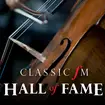The Full Works Concert - Friday 13 September 2013
Mozart's majestic, unfinished Requiem and Bruch's evergreen Violin Concerto feature among tonight's Full Works.
Tonight's concert opens with perhaps the most famous Viennese waltz of them all - By the Beautiful Blue Danube by Johann Strauss II. Given its popularity today, it’s surprising to consider that the piece was by no means an instant hit. The waltz first found favour in Paris after Viennese audiences had slightly turned their noses up at it. The French embraced Strauss as one of their own, and his melodies became favourites in the city, quickly overshadowing the homegrown talent of Offenbach.
When the Count von Walsegg's wife Anna died on Valentine’s Day 1791, it set in motion a series of events that, one could argue, has never stopped. Walsegg, an accomplished musician himself, anonymously commissioned a Requiem from Mozart, totally spooking the already unstable composer in the process. Mozart became consumed by the work, believing he had been cursed to write a requiem for himself, because he was about to die. The opening movement, Requiem aeternam, was the only section to be completed. The rest of the Requiem was brushed into some sort of shape by Mozart’s only composition pupil, Sussmay. Regardless, the Requiem still sounds wonderful to most ears.
Khachaturian was enjoying a good period in 1941. He had not long written his music for the ballet Happiness and his Violin Concerto. So when he was asked to provide incidental music for the revival of a play, Masquerade by Lermontov, he quickly agreed. Soon, however, he was beginning to regret his decision as the theme for a central waltz in the production eluded him. There is a section of the plot where the principal character, Nina, says, ‘How beautiful the new waltz is!’ she goes on to describe a work somewhere between sorrow and joy. Perhaps it was the pressure of so naked a line that caused Khachaturian sleepless nights. Soon, with a little help from a friendly teacher, he had his theme – and its exuberant place at the heart of this suite is probably the biggest single reason for its success.
Telemann's Concerto in D major for Trumpet and 2 Oboes is not so much a concerto in the Bach-Vivaldi tradition, but rather an elaborate chamber sonata for winds and continuo. This Concerto gives credence to a saying attributed to Telemann as advice to a young composer: 'Give every instrument its due/The player will be pleased, and the audience will, too.'
Bruch composed his famous first violin concerto in 1866 - and set himself up as something of a one-hit wonder. For violinists, one of the concerto’s most obvious redeeming qualities is the degree to which it acts as a profound showcase for the instrument. The second movement, meanwhile, is pure romance: beautiful, heart-breaking themes, woven delicately within soulful orchestral accompaniment.
Johann Strauss II: By the Beautiful Blue Danube
Georges Pretre conducts the Vienna Philharmonic Orchestra
Wolfgang Amadeus Mozart: Requiem
Soloists: Elizabeth Watts, Phyllis Pancella, Andrew Kennedy, Eric Owens, Robert Nairn
Harry Christophers conducts the Handel and Haydn Society
Aram Khachaturian: Masquerade Suite
Neeme Jarvi conducts the Royal Scottish National Orchestra
Georg-Philipp Telemann: Concerto in D major for Trumpet and 2 Oboes
Soloists: Sergei Nakariakov, Linda Strommen, Thomas Tempel
Hugh Wolff conducts the St. Paul Chamber Orchestra
Max Bruch: Violin Concerto No.1 in G minor
Violin: Maxim Vengerov
Kurt Masur conducts the Leipzig Gewandhaus Orchestra











